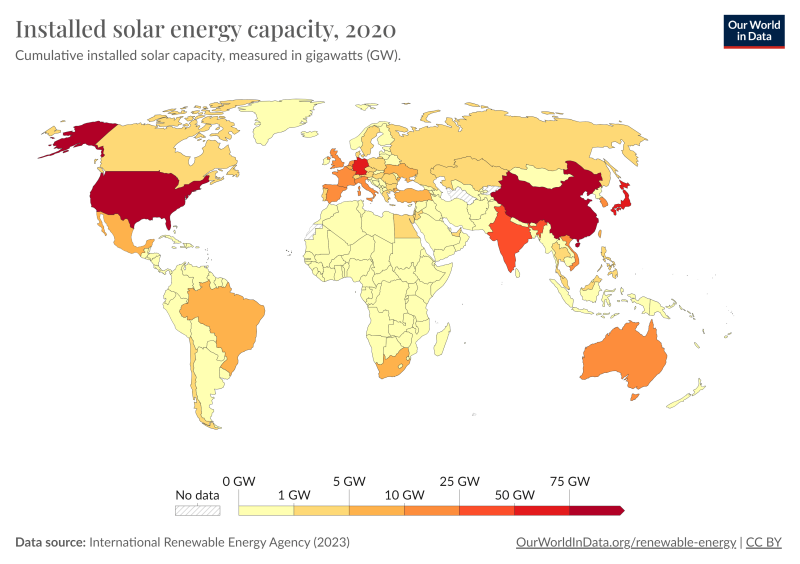Solar Power Generation
Installed capacity
According to IEA solar PV generation increased a record 156 TWh (23%) in 2020, with respect to 2019, to reach 821 TWh (cf Figure 1). It had the second-largest growth of all renewable technologies in 2020, slightly behind wind and ahead of hydropower. However, to achieve Net Zero emissions by 2050, an average annual solar power generation growth of 24% between 2020 and 2030 is necessary in order to reach the target of 8000 TWh (Terawatt-hour) of total power generation capacity. This almost tenfold increase in deployment requires a strong policy ambition and more efforts from both public and private stakeholders, especially in the areas of grid integration and the mitigation of policy, regulation and financing challenges, particularly in emerging and developing countries. Nevertheless, solar PV is becoming the lowest-cost option for electricity generation in most of the world, which is expected to propel investment in the coming years (Bojek and Bahar, 2021), considering also its vast natural resource (Figure 2).

Figure 1. Global solar energy installed capacity for 2020. Source: Our World in Data


Figure 2. Global mean power density (solar horizontal irradiation) for solar generation. Source: Global Solar Atlas.
Solar PV and grid management
The increase in PV solar contribution to the grids, can cause voltage and frequency fluctuations, harmonics, and flickering problems in the power supply, which might result in increasing overloading problems and voltage peaks for distribution network operators. As PV systems lack mechanical inertia and do not include any local governor, it becomes difficult for hybrid systems having high PV penetration to maintain system resiliency and stability.
Suitable models are developed to perform accurate PV integration estimations helping to tackle these technical constraints, to develop system operational strategies, or to achieve the optimal control of the Energy Storage System (ESS) that is needed to add flexibility to solar renewables. The distributed PV hosting capacity calculation does not only depend on voltage, frequency, and thermal limit of the associate distribution lines but also several other factors, for example, the amount of the system’s operating reserve, storage capacity, annual load profile, annual generator loading profile, PV systems’ diversity and fluctuation factors, step load capacities of generators, and generator start and runtime (David et al., 2021).
Solar forecasting
Solar irradiation presents more defined annual and daily cycles, but energy conversion by solar plants mainly depends on direct and diffuse radiation. The most common meteorological variable used is global horizontal irradiation (GHI). However, measuring solar irradiance has its challenges, because despite the wide distribution of solar energy, its availability varies greatly both spatially and temporally depending on geolocation and atmospheric conditions. The observable’s irregular variations (synoptic and inter-annual) are related to the movement and persistence of clouds and aerosols. Aerosols have a significant impact on conversion rates that can be low even in blue sky days. The emission source for aerosols and their precursors can be varied: heavily-polluted wildfire conditions, water-friendly aerosols, dust and other suspended particles, more important in desertic conditions or areas with serious industrial pollution (Liu et al., 2022).
Other meteorological variables that may influence the energy conversion and that have been included in probabilistic and statistical models are ambient temperature, wind velocity, humidity wind speed, wind direction, humidity, sea level pressure and cloud ice-water content (van Loeper et al., 2020).
Due to its major influence in power fluctuations, solar forecasting provides valuable information for grid management and maintenance. It is also used to estimate bids in electricity markets. There are models computing conditional probabilities of reverse power flow exceeding predefined critical thresholds at feed-in points of a distribution network.
The combination of high-resolution imagery and artificial intelligence offers some possibility to improve the real time estimation of PV generation. Satellite-based forecasting tools account for the short-term intra-day time horizons, typically outperforming numerical weather predictions up to 4–5 h ahead. The method consists of three separated stages, namely, cloud motion estimation, motion extrapolation and satellite-to-irradiation conversion (Aicardi et al. 2022).
Value of the forecasts
A review of the direct impact of deterministic day-ahead forecasts, relating the forecast skill (mean absolute error, MAE) with economic gain, showed that there is an almost linear relationship with the economic gain brought by applying the forecast. More precisely, an improvement of 1% point in MAE results approximately in an increase of 2% points in economic gain (David et al 2021).
References
- Global Solar Atlas
- Aicardi, D., Musé, P., Alonso-Suárez, R. 2022. A comparison of satellite cloud motion vectors techniques to forecast intra-day hourly solar global horizontal irradiation, Solar Energy, Vol. 233, pp 46-60.
- Bojek, P. and Bahar, H. 2021. Solar Power. Tracking report. International Agency of Energy (IEA).
- Liu, Y., Qian, Y., Feng, S., Berg, L. K., Juliano, T. W., Jiménez, P.A., Liu, Y. 2022. Sensitivity of solar irradiance to model parameters in cloud and aerosol treatments of WRF-solar, Solar Energy, Vol 233, pp 446-460.
- F. von Loeper, F., Schaumann, P., de Langlard, M., Hess, R., Bäsmann, R., Schmidt, V. 2020. Probabilistic prediction of solar power supply to distribution networks, using forecasts of global horizontal irradiation, Solar Energy, Volume 203, pp 145-156.
- David, M., Boland, J., Cirocco, L., Lauret, P., Voyant. C. 2021. Value of deterministic day-ahead forecasts of PV generation in PV + Storage operation for the Australian electricity market, Solar Energy, Vol 224, pp 672-684.